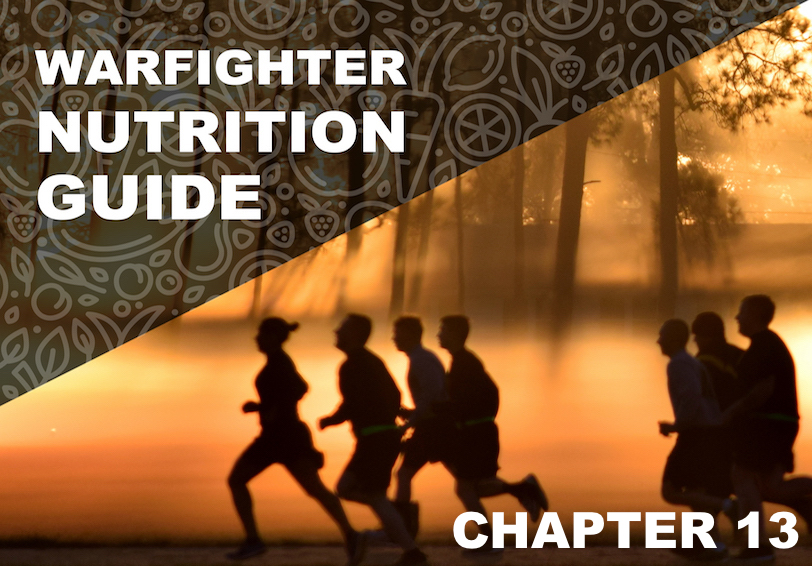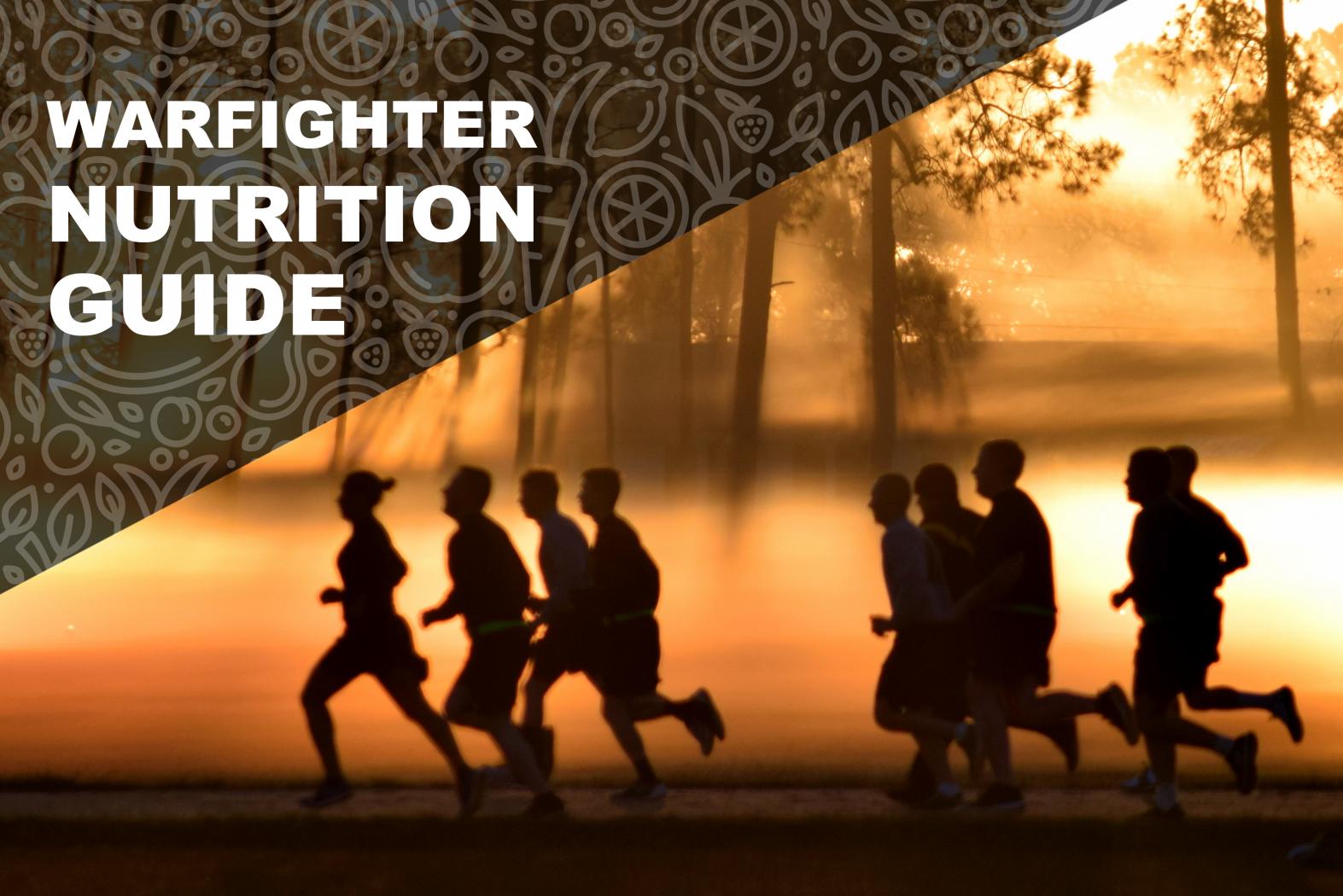- Headquarters, Departments of the Army, the Navy, & the Air Force. (2017). Nutrition and menu standards for human performance optimization (AR 40–25/OPNAVINST 10110.1/MCO 10110.49/AFI 44–141). Departments of the Army, the Navy, and the Air Force, Washington, DC. Retrieved from: https://armypubs.army.mil/epubs/DR_pubs/DR_a/pdf/web/AR40-25_WEB_Final.pdf
- Defense Logistics Agency. Rations Programs/Products. DLA Troop Support Subsistence. Retrieved 27 April 2017 from http://www.dla.mil/TroopSupport/Subsistence/Operationalrations/RationsPrograms.aspx
- Institute of Medicine, Food and Nutrition Board, Committee on Military Nutrition Research, & Committee on Optimization of Nutrient Composition of Military Rations for Short-Term High-Stress Situations (Eds.). (2006). Nutrient Composition of Rations for Short-term, High-intensity Combat Operations. Washington, DC: National Academies Press.
Key Points
- Combat rations provide optimal amounts of energy and nutrients to meet the needs of Warfighters in various operational environments.
- Good nutrition is a key enabler for successful military operations.
- Enhancement packs also are available to supplement military rations with components tailored to specific operational environments.
Military rations are the cornerstone of combat and field feeding. The type of ration a Warfighter needs depends on his or her unit’s mission, location, and availability of personnel and equipment to prepare meals. All military rations are designed to meet or exceed the nutritional standards in AR 40-25, OPNAVINST 10110.1/MCO 10110.49, and AFI 44-141: Nutrition and Menu Standards for Human Performance Optimization.1 Warfighters should consume all or most of the rations provided because they’re specially formulated to provide the fuel needed for optimal performance. This chapter provides an overview and descriptions of selected rations. Combat Rations Database (ComRaD) provides detailed nutrition information for Meal, Ready-to-Eat (MRE), First Strike Rations® (FSR), Meal, Cold Weather (MCW), and others. All of these are available in multiple menu options.2
Individual rations
Meal, Ready-to-Eat (MRE)
MRE is the primary general-purpose ration for the individual Warfighter. Issued as a self-contained combat ration, it’s designed for use as a single meal. Each MRE provides about 1,285 calories, including 40 grams protein, 176 grams carbohydrate, and 47 grams fat, meeting or exceeding the nutritional standards for operational rations.
Several ration components are fortified with specific vitamins and minerals to optimize nutritional content.3 In a field environment, however, Warfighters often remove ration components to reduce weight. If you choose to “field strip,” don’t remove your entrée or fortified items such as beverage bases, chocolate protein drink, cheese spread, peanut butter, crackers, snack breads, pudding, fruits, and First Strike bars. Otherwise, you won’t have the energy and nutrients you need to perform optimally.
Warfighters can consume MREs as their sole source of nutrition for up to 21 days. When MRE is the sole ration, units also should be provided with supplements (for example, milk) and enhancements (for example, bread and fresh fruit) whenever possible. After 21 days, other appropriate rations should be included in the daily field-feeding plan.
Meal, Cold Weather (MCW)
MCW is an individual ration designed for use during missions in extreme cold weather. The lightweight MCW contains dehydrated, precooked entrees and other low-moisture foods (granola, dried fruits, nuts, ramen noodle soup) that will not freeze. Each menu includes several beverages to encourage water consumption and prevent dehydration during cold-weather activities. Approximately 28–40 ounces of potable water are needed to rehydrate the ration components within each menu.
Each MCW menu provides an average of 1,600 calories, including 51 grams of protein, 227 grams of carbohydrates, and 58 grams of fat. Three MCWs (food for 24 hours) provide more than 4,500 calories, which is needed to meet the increased energy requirements when conducting operations in extreme cold-weather environments.
First Strike Ration® (FSR)
FSR is a compact, eat-on-the-move assault ration designed for use by an individual during short-duration, high-intensity missions.3 FSR is substantially lighter and more compact than MRE, enhancing Warfighter consumption, nutritional intake, and mobility. FSR contains familiar, eat-out-of-hand foods that require little or no preparation.
Each FSR (food for 24 hours) provides around 2,900 calories, including 91 grams protein, 421 grams carbohydrates, and 98 grams fat.
Group rations
The family of Unitized Group Rations (UGR) provides high-quality group meals to Warfighters during operations that allow organized food-service facilities. Each UGR contains all the items necessary for field-feeding 50 Warfighters, allowing culinary specialists to focus on food preparation instead of administration.
There are multiple ration types in the UGR family, including UGR-A, UGR-Heat & Serve (UGR-H&S), UGR-Marines (UGR-M), and UGR-Express (UGR-E).
UGR-A
UGR-A consists of both shelf-stable and perishable components. It delivers the highest-quality, most fresh-like field-feeding ration available anywhere. UGR-A is the only military operational ration that contains frozen food components. For this reason, it’s based on a build-to-order assembly process that requires refrigerated or frozen storage and a field kitchen for preparation. The average UGR-A menu, including shelf-stable milk, provides approximately 1,270 calories, including 52 grams protein, 161 grams carbohydrates, and 45 grams fat.
UGR-A, Short-Order expands the variety of food choices, offering a choice between standard UGR-A “mainline” and “short-order” dinners.
UGR-H&S
UGR-H&S is the first group ration available for use in theater. Used in combination with MRE for daily feeding, its components are shelf stable and can be prepared in field kitchens without refrigeration. Each menu contains an entrée, starch, vegetable, and dessert.
The average UGR-H&S menu, including shelf-stable milk, provides approximately 1,370 calories, including 47 grams protein, 183 grams carbohydrates, and 50 grams fat.
UGR-M
UGR-M (formerly UGR-B) is the primary group ration for the Marine Corps. It meets the Marines’ expeditionary requirements for high-quality group rations that are shelf stable (no refrigeration needed), quick, and easy to prepare. The average UGR-M menu, including shelf-stable milk, provides approximately 1,300 calories, including 46 grams protein, 176 grams carbohydrates, and 46 grams fat.
UGR-E
UGR-E provides complete group meals for Warfighters in remote locations where group field feeding wouldn’t otherwise be possible. In addition, these meals don’t require cooks or a field kitchen for preparation. With the simple pull of a tab, UGR–E is ready to serve in 30–45 minutes. One UGR-E module provides everything needed for a complete meal, including entrées, starches, vegetables, desserts, drink pouches, snacks or candies, dining trays, seasonings, disposable eating and serving utensils, condiments, beverages, napkins, wet-naps, and trash bags.
Each meal provides approximately 1,360 calories, including 39 grams protein, 179 grams carbohydrates, and 55 grams fat.
Survival rations
Survival, General Purpose
Survival, General Purpose can sustain anyone in survival situations (including escape and evasion, all environmental conditions, and when potable water is limited) for periods up to 5 consecutive days. The ration contains 5 compressed bars (2 cereal bars and 3 cookie bars), wintergreen tablets, lemon tea, and soup base. Each packet provides approximately 1,450 calories, including 18 grams protein, 200 grams carbohydrates, and 63 grams fat. This ration provides crucial nutrients and minimizes carry weight (one packet weighs 11.4 ounces). You’ll need 14 oz water to reconstitute the lemon tea and soup.
Survival, Abandon Ship
The Navy uses this ration when it’s necessary to abandon ship. Designed to fit in the storage areas of lifesaving craft, each packet contains a minimum of 6 individually wrapped bars (2 per day for 3 days) to sustain one person. The ration is strictly short-term survival food to minimize the effects of acute starvation. Each 20-ounce packet provides approximately 2,400 calories (54% carbohydrates) and is compatible with potable water restrictions.
Survival, Aircraft, Life Raft
The Navy uses this ration to sustain personnel who survive aircraft disasters at sea. The packet, along with other essential equipment, is supplied in emergency kits on naval aircraft. The ration weighs 3.5 ounces and contains hard candy and candy-coated chewing gum. It also includes an instruction sheet explaining that the food is good for a 24-hour period, even when water supply is limited. Each packet provides approximately 300 calories (100% carbohydrates). It’s strictly short-term survival food to reduce the effects of acute starvation. The components also are compatible with potable water restrictions.
Special-purpose rations
Meal, Religious, Kosher/Halal
The Meal, Religious, Kosher/Halal is for those who maintain a strict religious diet. Each meal consists of one Kosher- or Halal-certified entrée and religiously certified or acceptable complementary items. Like MRE, it’s a complete, self-contained meal that provides approximately 1,330 calories, including 36 grams protein, 178 grams carbohydrates, and 53 grams fat. A Kosher for Passover version also is available.
Enhancement packs
Modular Operational Rations Enhancement (MORE)
Warfighters in extreme environments such as cold weather, high altitude, or elevated temperature require extra calories beyond the standard operational rations in order to combat weight loss and decreased physical and cognitive performance. MORE provides extra calories for these unique environmental scenarios. It isn’t intended to replace a ration. Instead, these are nutritionally balanced additions that help ensure peak performance, even in harsh battlefield conditions.
MORE contains lightweight, compact, eat-on-the-move components that are easy to consume and digest. Each pack weighs about 0.75 pounds and provides approximately 1,000 calories per pack.
Combat rations research and development
The mission of the DoD Combat Feeding Research and Engineering Program is to provide an operationally relevant research-and-development base to deliver solutions for evolving field-feeding challenges.
The Combat Feeding Directorate is responsible for the research, development, engineering, integration, and technical support for the entire family of operational rations.2 The program is driven by Warfighter recommendations and feedback.

